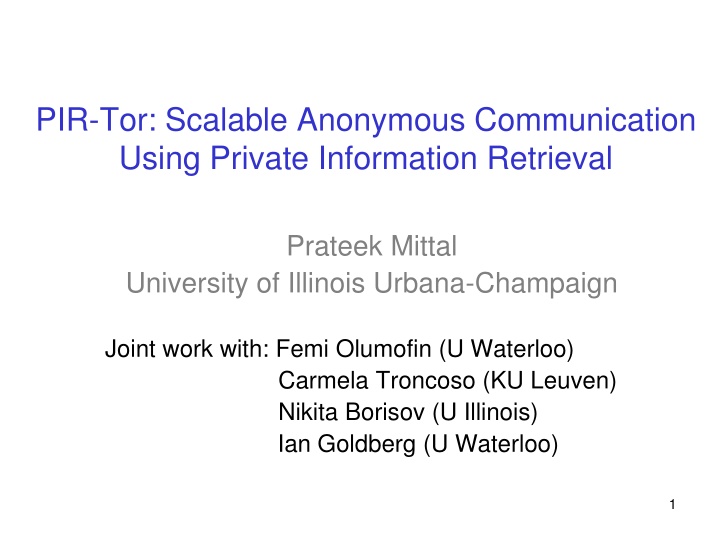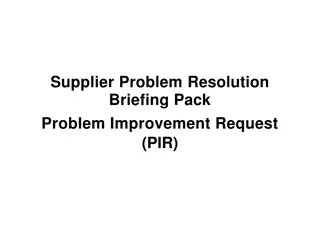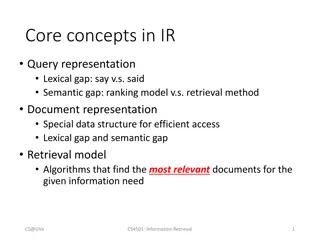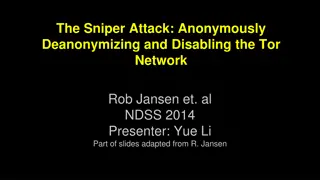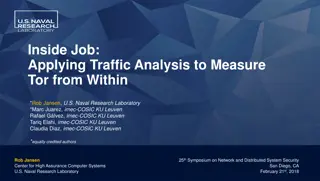PIR-Tor: Scalable Anonymous Communication Using Private Information Retrieval
Anonymous communication via PIR-Tor allows users to communicate while keeping their identities secret from third parties. This research discusses the background of Tor, performance issues in its architecture, current solutions, design goals for improvement, and key observations for enhancing relay selection security to maintain anonymity.
Download Presentation

Please find below an Image/Link to download the presentation.
The content on the website is provided AS IS for your information and personal use only. It may not be sold, licensed, or shared on other websites without obtaining consent from the author.If you encounter any issues during the download, it is possible that the publisher has removed the file from their server.
You are allowed to download the files provided on this website for personal or commercial use, subject to the condition that they are used lawfully. All files are the property of their respective owners.
The content on the website is provided AS IS for your information and personal use only. It may not be sold, licensed, or shared on other websites without obtaining consent from the author.
E N D
Presentation Transcript
PIR-Tor: Scalable Anonymous Communication Using Private Information Retrieval Prateek Mittal University of Illinois Urbana-Champaign Joint work with: Femi Olumofin (U Waterloo) Carmela Troncoso (KU Leuven) Nikita Borisov (U Illinois) Ian Goldberg (U Waterloo) 1
Anonymous Communication What is anonymous communication? ? Routers Allows communication while keeping user identity (IP) secret from a third party or a recipient Growing interest in anonymous communication Tor is a deployed system Spies & law enforcement, dissidents, whistleblowers, censorship resistance 2
Tor Background Directory Servers Trusted Directory Authority List of servers? Middle Signed Server list (relay descriptors) Exit Guards 1. Load balancing 2. Exit policy 3
Performance Problem in Tors Architecture: Global View Global view Not scalable Directory Servers List of servers? Need solutions without global system view 4 Torsk CCS09
Current Solution: Peer-to-peer Paradigm Morphmix [WPES 04] Broken [PETS 06] Salsa [CCS 06] Broken [CCS 08, WPES 09] NISAN [CCS 09] Broken [CCS 10] Torsk [CCS 09] Broken [CCS 10] ShadowWalker [CCS 09] Broken and fixed(??) [WPES 10] Very hard to argue security of a distributed, dynamic and complex P2P system. 5
Design Goals A scalable client-server architecture with easy to analyze security properties. Avoid increasing the attack surface Equivalent security to Tor Preserve Tor s constraints Guard/middle/exit relays, Load balancing Minimal changes Only relay selection algorithm 6
Key Observation Need only 18 random middle/exit relays in 3 hours So don t download all 2000! Na ve approach: download a few random relays from directory servers Problem: malicious servers Route fingerprinting attacks Relay # 10, 25 Directory Server Download selected relay descriptors without letting directory servers know the information we asked for. Private Information Retrieval (PIR) 25: IP address, key 10: IP address, key Bob 10 25 Inference: User likely to be Bob 7
Private Information Retrieval (PIR) Information theoretic PIR Multi-server protocol Threshold number of servers don t collude A B Computational PIR Single server protocol Computational assumption on server Database C A Only ITPIR-Tor in this talk See paper for CPIR-Tor RA Database 8
ITPIR-Tor: Database Locations Tor places significant trust in guard relays 3 compromised guard relays suffice to undermine user anonymity in Tor. Choose client s guard relays to be directory servers At least one guard relay is honest All guard relays compromised Equivalent security to the current Tor network Exit relay compromised: Exit relay honest Middle Middle Exit Exit Middle Middle Exit Exit End-to-end Timing Analysis Deny Service ITPIR guarantees user privacy ITPIR does not provide privacy But in this case, Tor anonymity broken Guards Guards Guards Guards 9
ITPIR-Tor Database Organization and Formatting Middles, exits Separate databases Exit policies Standardized exit policies Relays grouped by exit policies Load balancing Relays sorted by bandwidth Sort by Bandwidth Relay Descriptors m1 e1 m2 e2 Exit Policy 1 m3 e3 m4 m5 m6 m7 m8 e4 e5 e6 e7 e8 Exit Policy 2 Non- standard Exit policies Middles Exits 10
ITPIR-Tor Architecture Guard relays/ PIR Directory servers Trusted Directory Authority 2. Initial connect 1. Download PIR database 3. Signed meta-information 5. 18 PIR Queries(1 middle/exit) 5. 18 middle,18 PIR Query(exit) 6. PIR Response m1 e1 m2 e2 4. Load balanced index selection m3 e3 m4 m5 m6 m7 m8 e4 e5 e6 e7 e8 Middles Exits 11
Performance Evaluation Percy [Goldberg, Oakland 2007] Multi-server ITPIR scheme 2.5 GHz, Ubuntu Descriptor size 2100 bytes Max size in the current database Exit database size Half of middle database Methodology: Vary number of relays Total communication Server computation 12
Performance Evaluation: Communication Overhead Advantage of PIR-Tor becomes larger due to its sublinear scaling: 100x--1000x improvement 1.1 MB 216 KB 12 KB Current Tor network: 5x--100x improvement 13
Performance Evaluation: Server Computational Overhead 100,000 relays: about 10 seconds (does not impact user latency) Current Tor network: less than 0.5 sec 14
Performance Evaluation: Scaling Scenarios Tor Communication (per client) ITPIR Communication (per client) ITPIR Core Utilization Scenario Explanation Relay Clients Current Tor 2,000 250,000 1.1 MB 0.2 MB 0.425 % 10x relay/client 20,000 2.5M 11 MB 0.5 MB 4.25 % Clients turn relays 250,000 250,000 137 MB 1.7 MB 0.425 % 15
Conclusion PIR can be used to replace descriptor download in Tor. Improves scalability 10x current network size: very feasible 100x current network size : plausible Easy to understand security properties Side conclusion: Yes, PIR can have practical uses! Questions? 16
